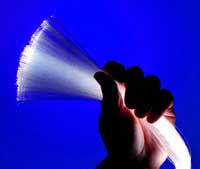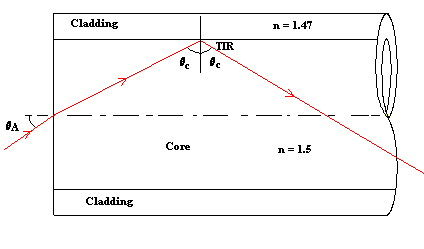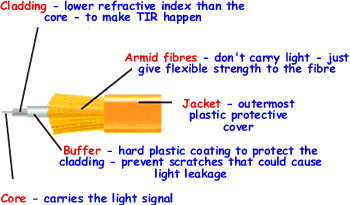    |
||||

Optical Fibres |
||||
|
Optical fibres are used to carry signals in the form of pulses of light over distances up to 50km. They do this by Total Internal Reflection. That's why optical fibers can guide light for such long distances - because the walls of the fibre don't absorb any light at all as long as the angle of incidence is greater than the critical angle. Total Internal Reflection causes 100% reflection. In no other situation in nature does this occur, so it is unique and very useful as it is 100% efficient at transfering the light energy. There are two conditions necessary for Total Internal Reflection to occur:
When light hits the boundary between two substances it gets reflected and refracted. Light principally refracts at low angles of incidence, but as the angle of incidence increases the percentage of the light energy that reflects rather than refracts
increases until the internal surface acts as a mirror. This is called TOTAL INTERNAL REFLECTION, because all of the incident light energy
is reflected. The reflection then is even better than at a mirror's surface because 100% of the light energy is reflected by TIR whereas reflection at a mirror surface is never 100%. Construction (not required at GCSE)A fibre optic cable is made from a glass core (or in cheaper lower grade ones - plastic), that carries the light, surrounded by a glass cladding of lower refractive index, which reflects “escaping” light back into the core. Without the cladding the light would pass between the fibres as they are all made of glass, would not have a lower refractive index boundary for TIR to occur at and therefore would allow light transfer. They are about usually about 120 micrometers in diameter.(very thin strands)
The overall cable construction is shown in the diagram below
Advantages over Copper Cable
Disadvantages to Copper Cable
Areas of Application
Communications (telephone, cable TV)Fibre-optic cables use light to transmit information over great distances at high speed. They are used widely in telecommunications because of their many advantages over copper cable.They are smaller, cheaper (overall) because you can snd more information with less 'degradation' or signal loss than other kinds of cables. Today these cables are found in local cable TV and internet connections and most international telephone networks. The fibres used in long-distance telecommunications are made of very pure glass rather than plastic, because glass does not absorb the enegy of the light signals as much as plastic does. For shorter distances, plastic is often used as it is cheaper. For very short distances, fibre-optics are not the best choice. Cables such as copper wires and coaxial cable, which transit information using electricity are easier to join together or splice into new circuits. In very short distances, there is very little need for the speed and huge volumes of transmission that fibre optic cables can offer A Telecommunications Link is the simplest of fibre optic systems.
It consists basically of a transducer (to change the electrical signal into light energy), a transmitter (that generates light pulses to travel along the fibre) , a fibre link and a receiver to detect the light gignals and transfer them into electrical output. The transmitter will normally be equipped with a laser diode that usually has an output wavelength of 1300nm or 1500nm. The fibre link will be made of single lengths of
optical fibres 2km in length, which are fusion spliced (joined) together.
The link will be able to carry thousands of telephone conversations simultaneously
by means of time division multiplexing. This basically means that the
data in multiple conversations is split up and sent down the cable.
When it reaches the other end of the cable, the individual conversations
This would not be possible with copper cabling. Microbending SensorA microbending sensor consists of two plates between which passes an optical fibre. The plates have parallel grooves on their facing surfaces and the grooves from the two plates interleave with each other. The fibre passing between the plates is therefore bent alternatively up and down. When a fibre is bent sufficiently the light in the core no longer meets the cladding at an angle equal to or greater than the critical angle. Total Internal Reflection therefore does not occur. This is called microbending loss, and the more a plate is bent, the more loss occurs. This has a military application of submarine detection. Blood Components SensorIf we use the correct wavelength we can measure the concentrations of specific components of blood such as total protein, cholesterol, urea and uric acid quickly. When the concentration is high, the output at the detector is less and vice versa. The concentrations of those chemicals are important to doctors in the diagnosis and monitoring of certain disease conditions. Fibre optic sensors can give results very quickly without having to send samples away to an analytical lab.
|
||||
 |
||||

 Optical fibres
are just 'reflective tubes'. If you shine light down the tube, and it
keeps going because it bounces from the walls. But if you've ever looked
at optical fibres, you'll notice that they are NOT METALLIZED like a mirror,
they have no silvery coating. They look like transparent fishing line.
Optical fibres
are just 'reflective tubes'. If you shine light down the tube, and it
keeps going because it bounces from the walls. But if you've ever looked
at optical fibres, you'll notice that they are NOT METALLIZED like a mirror,
they have no silvery coating. They look like transparent fishing line.





